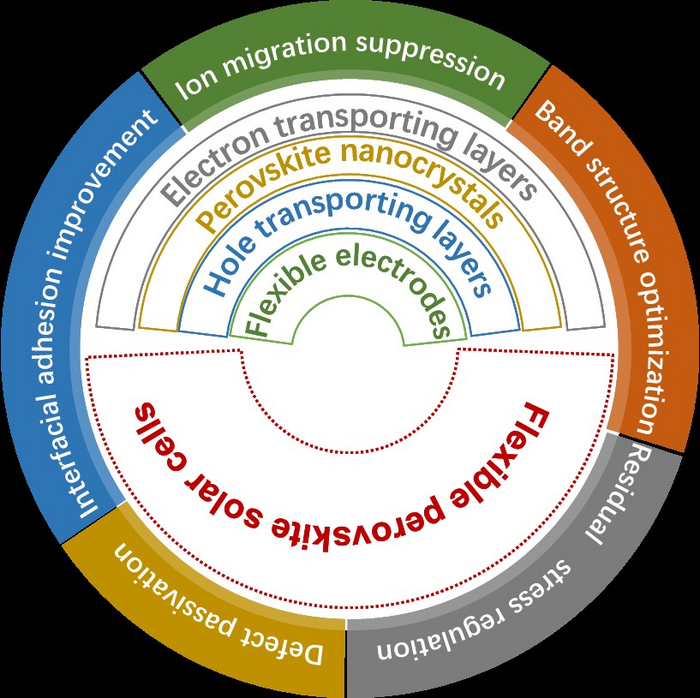Recent research published on December 21st, 2022, in the Energy Material Advances journal outlines the degradation mechanisms and examines the interfacial engineering focusing on their impacts on flexible perovskite solar cells.

Image Credit: Qi Chen, Beijing Institute of Technology
“For the perovskite film, there are some factors influencing the intrinsic material stability, (a) Stress would accumulate with temperature changes because of mismatched lattice and thermal expansion coefficients. It brought about delamination, or accelerated decomposition. (b) Both water vapor and oxygen could have an irreversible reaction with the perovskite crystal. (c) Illumination causes the weak link in the perovskite or adjacent layers to break,” states paper author Qi Chen.
Qi Chen is a Professor from Beijing Key Laboratory of Construction Tailorable Advanced Functional Materials and Green Applications, MIIT Key Laboratory for Low-Dimensional Quantum Structure and Devices, Experimental Center of Advanced Materials, School of Materials Science and Engineering, Beijing Institute of Technology.
Chen highlighted that, in addition to the above rigid device stabilizing parameters, the stability of f-PSC is affected by other conditions. The mechanism of degradation of flexible electronics should be investigated and summarized in greater depth.
Interface Modification can passivate defects, improve interfacial adhesion, suppress ion migration, optimize band structure and regulate residual stress. Based on the latest research progress, we summarize the application of Interface Modification in flexible perovskite solar cells.
Qi Chen, Paper Author, Professor, Beijing Key Laboratory of Construction Tailorable Advanced Functional Materials and Green Applications
Interface Modification can enhance the capability of the transport layer to restrict water and oxygen, as well as decrease interface recombination, by managing the SnO2 nanocrystals, which is the key to improving device performance.
The rough shape of the flexible substrate directly impacts the quality of the perovskite film in the active layer, and deep energy level flaws inside and on the surface lead to higher interfacial nonradiative recombination.
Interface Modification enhances the quality of the perovskite film and its interfacial adhesion and flexibility, boosting cell performance as a result.
Interfacial engineering can also enhance the durability, conductivity, and transparency of flexible electrodes.
“To further improve the efficiency and stability of f-PSCs, the complex interplay between those different interfaces should be studied in detail. Interfacial engineering plays a critical role in the optoelectronic performance of f-PSCs. We systematically investigate the influence of the flexible substrate on charge extraction, charge transportation, and charge recombination in f-PSCs. A deeper understanding of interfacial charge dynamics is conducive to figuring out the degradation mechanism of f-PSC,” Chen adds.
Despite significant progress in recent years, f-PSCs have to reach large-scale production and commercial operation. Therefore, interface engineering is still the key way to solve the issues plaguing the functionality and operation of f-PSCs.
Qi Chen, Paper Author, Professor, Beijing Key Laboratory of Construction Tailorable Advanced Functional Materials and Green Applications
A complete understanding of the interfacial properties and associated charge carrier dynamics is required for the future industrialization of f-PSC. The revolutionary active light-absorbing material and CTL could be developed to suit the requirements of large-area device production until sufficient knowledge is acquired. After lowering photovoltaic energy loss and resolving instabilities, f-PSC industrialization could be encouraged.
Second, for flexible tandem cells, interfacial engineering is necessary. If subcells are joined in series, the interconnection layers must have exceptional charge-carrying ability to function as recombination layers. Furthermore, the upper layer should ensure that the rear cell absorbs enough light. Only via careful management of the interface quality are those tandem cells visually thick and electrically thin enough. The general population understands the actual potential of flexible perovskite photovoltaic devices.
Jie Dou, Beijing Key Laboratory of Construction Tailorable Advanced Functional Materials and Green Applications, MIIT Key Laboratory for Low-Dimensional Quantum Structure and Devices, Experimental Center of Advanced Materials, School of Materials Science and Engineering, Beijing Institute of Technology contributed to the study.
The research was funded by the National Natural Science Foundation of China (U21A20172 and 21975028), the Beijing Natural Science Foundation (JQ19008), and the China Postdoctoral Science Foundation (2020M670144).
Journal Reference:
Dou, J. & Chen, Q. (2022) Interfacial Engineering for Improved Stability of Flexible Perovskite Solar Cells. Energy Material Advances. doi.org/10.34133/energymatadv.0002.